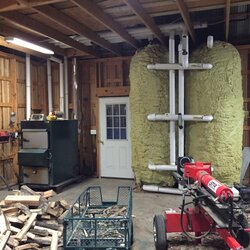Dear all, I've been reading up on boiler systems for six months now (largely on this very helpful forum), and am just about ready to take the plunge.
I've settled on a Frohling system, and was going for a 40/50. The house is about 4,200 sqft, and reasonably tight (mid-'80s, so oil-crisis thinking).
In addition to keeping me toasty warm and helping out the environment, one of the main aims of the system is to keep the house at a safe non-freeze temperature when I'm not home - which tends to be about 4 days per week. The plan was to oversize the water tanks, so that there'd be sufficient buffer to do this effectively, with an existing relatively new buderus oil burner as backup, to kick in once the water tanks get below the temp at which they're effective. I would like the frohling to do most of the work though, for as many hours as possible whilst I'm away.
The problem is however, that the pressurized tanks that have been recommended run at $10,000 per 600 gallons of storage (tanks alone, not the boiler or pipework) - so $20,000 for our needs (providing 1,200 gallons of pressurized storage). This figure has completely blown the overall boiler project budget out of the water, and pretty much makes it a non-starter.
I've been reading that a lot of people use re-purposed LPG tanks in lieu of certified pressurized water tanks, but I wonder if anyone has any opinions on 1) using LPG tanks effectively and safely. 2) whether there are cheaper certified tanks out there. 3) whether we could achieve our goals by using larger, non-pressurized tanks (we have plenty of space in the basement). 4) any other way that the system could achieve our goals without costing $45,000 in total.
I really appreciate any insights that anyone is able to offer.
Thanks.
I've settled on a Frohling system, and was going for a 40/50. The house is about 4,200 sqft, and reasonably tight (mid-'80s, so oil-crisis thinking).
In addition to keeping me toasty warm and helping out the environment, one of the main aims of the system is to keep the house at a safe non-freeze temperature when I'm not home - which tends to be about 4 days per week. The plan was to oversize the water tanks, so that there'd be sufficient buffer to do this effectively, with an existing relatively new buderus oil burner as backup, to kick in once the water tanks get below the temp at which they're effective. I would like the frohling to do most of the work though, for as many hours as possible whilst I'm away.
The problem is however, that the pressurized tanks that have been recommended run at $10,000 per 600 gallons of storage (tanks alone, not the boiler or pipework) - so $20,000 for our needs (providing 1,200 gallons of pressurized storage). This figure has completely blown the overall boiler project budget out of the water, and pretty much makes it a non-starter.
I've been reading that a lot of people use re-purposed LPG tanks in lieu of certified pressurized water tanks, but I wonder if anyone has any opinions on 1) using LPG tanks effectively and safely. 2) whether there are cheaper certified tanks out there. 3) whether we could achieve our goals by using larger, non-pressurized tanks (we have plenty of space in the basement). 4) any other way that the system could achieve our goals without costing $45,000 in total.
I really appreciate any insights that anyone is able to offer.
Thanks.


 ) Other vendors may do the same thing.
) Other vendors may do the same thing.